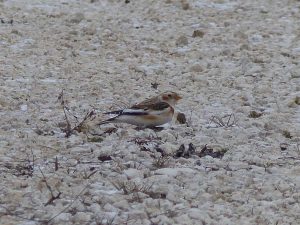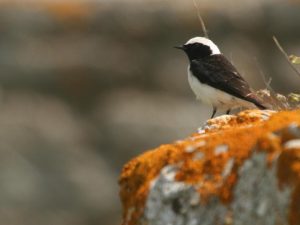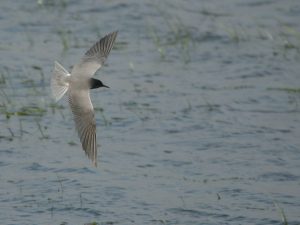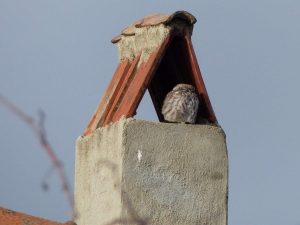
easy birding on the Black Sea coast
An easy birdwatching tour, focusing on the southbound migrants of the Black Sea coast.
Download leaflet
Dates
To be confirmed
Leaders
To be confirmed
Price
To be confirmed
Included
Return flight London Heathrow to Bulgaria. Local transport as specified in the itinerary. Seven nights’ accommodation, full board.
Not included
Refreshments. Gratuities. Travel insurance. Covid tests and associated costs.
Group size
Minimum 5, maximum 14.
The Black Sea flyway, known as the Via Pontica, is one of the busiest migration routes in Europe, rivalling those of Gibraltar and the Bosphorus, as the birds of northern Europe are funnelled through the bottle-neck between the coast and the mountains, on their way south.
We start in coastal Dobroudzha, exploring the remnant steppe grasslands and dramatic cliffs of Cape Kaliakra, home to breeding Calandra Lark and Pied Wheatear, with migrant larks, pipits, chats and shrikes. The area is also home to the highest density of Wild Cats in Europe, an exciting possibility on any visit.
Nearby, the great lakes of Durankulak and Shabla attract mixed flocks of Whiskered and Black Terns. Amongst the wildfowl and water birds we should be able to pick out Ferruginous Duck and Pygmy Cormorant; the surrounding bushes may hold migrating warblers, flycatchers, shrikes and chats, alongside resident Syrian Woodpecker.
The second part of our holiday is spent around the Bourgas wetlands. Here one of the great attractions should be the huge flocks of pelicans that roost on the lakes during their migration. The shallows of Atanasovsko Lake attract a good variety of waders, with Broad-billed or Marsh Sandpipers a strong possibility. We spend a morning at Dyulinksi Pass, a superb watchpoint at the end of the Eastern Balkan Range from where we hope to observe the migration of raptors and other soaring birds – White and Black Storks; Lesser Spotted, Booted and Short-toed Eagles; Levant Sparrowhawk, Honey Buzzard Red-footed Falcon, and four harrier species may all pass overhead.
Download trip report
Please note that holidays change, although sometimes only slightly, from year to year and previous trip reports may not reflect the planned itinerary, or other holiday details, for the current trip. Please ask us if you would like to know of any significant differences.
Day 1 Our fight takes us to Varna on the Black Sea coast from where we transfer to our hotel, just over an hour away.
Day 2-3 We spend some time exploring Cape Kaliakra and the nearby steppe where bird specialities should include Pied Wheatear, Calandra Lark and perhaps Stone Curlew, while migrant flycatchers, chats, shrikes and warblers are passing through the bushes.
We will also visit two interesting wetlands, Lakes Durankulak and Shabla. Birds here could include Red-footed Falcon, Pygmy Cormorant and Ferruginous Duck. Resident and wintering raptors here include Long-legged Buzzard, Short-eared Owl and the secretive Eagle Owl.
Day 4 A travelling day takes us south towards Bourgas. Along the way we will pass the ancient riverine forest around the Kamchia River, we hope to find woodland birds here including Red-breasted Flycatcher, Grey-headed Woodpecker and Hawfinch. Continuing into the Balkan Mountains we make several stops along the way, hoping to find wheatears and Whinchats in the foothills, and Sombre Tit and Middle-spotted Woodpecker in the village orchards.
Our journey takes us through the Dyulino Pass, which offers superb opportunities for watching migration. In the right conditions, this can be one of the most impressive visual migrations in Europe – we can hope to see Lesser Spotted, Booted and Short-toed Eagles, harriers, buzzards and falcons, storks and pelicans, sometimes in very large numbers.
Day 5-7 We explore the internationally important wetlands of the Bourgas area. The shallow water of Atanasovsko Lake attracts large numbers of wading birds, and migrants could include both Marsh and Broad-billed Sandpiper together with Red-necked Phalarope. Gulls and terns also gather here, giving us the chance to differentiate between Black-headed, Slender-billed, Mediterranean and Little Gulls. The brackish Vaya Lake (Bourgas Lake) is Bulgaria’s largest natural lake. Home to large numbers of breeding herons and egrets, Vaya Lake is also the favourite local feeding ground for White and Dalmatian Pelicans, which can often be seen side by side. Lake Mandra, a freshwater reservoir, lies to the south of Bourgas and is the deepest of its lakes. Migrating flocks of pelicans often stop off here to roost, while at least one pair of White-tailed Eagles is resident in the area. We will also visit the salt pans of Pomorie Lake, famous for its curative mud, where we should find plenty of waders to keep us entertained.
Day 8 We retrace our steps towards Varna, making some stops along the way before we reach the airport for our afternoon flight home.
Please note that the itinerary may be changed to suit the weather or other practicalities at the discretion of the leaders.
Our accommodation will be at good three-star local hotels, all with en-suite accommodation, with our time split between the coastal town of Kavarna, and the outskirts of the city of Burgas.
Meals provided during the stay will be a mixture of Balkan and International dishes, with an emphasis on local cuisine and plenty of salads. Requests for special diets can be accommodated.
We will travel by minibus or smaller vehicles if necessary.
Group flights
Group flights are with with Austrian Airlines from London Heathrow to Varna.
It would also be possible to fly from Manchester, Birmingham or Edinburgh, with Lufthansa: please speak to us about options.
Overland travel
You can reach Bulgaria by train from the UK. From London you can reach Sofia in two nights, with sleeper trains available. Contact us to find out more, and to make your holiday flight-free.
Time zone
Bulgaria is two hours ahead of UK time.
Entry requirements
If you hold a British passport you can travel to countries in the Schengen area (including Bulgaria) for up to 90 days in any 180-day period without a visa. Your passport must be issued less than ten years before the date you enter the country and valid for at least three months after the day you plan to leave.
Starting in 2026 British passport holders will need to apply for the ETIAS European Travel Authorisation to visit Schengen countries. This must be applied for online prior to travel, at a cost of €7 (free for over 70s). Once granted, your ETIAS will be valid for three years.
At this time of year the weather is usually sunny but not too hot. However, as with everywhere the weather is no longer entirely predictable, and there may be some cooler weather, rain or wind.
On most days, we are walking for much of the day, albeit at a relatively slow pace. It is necessary to walk on rougher ground and up some (gentle) slopes, although none of the walking is strenuous. Good (light) walking boots are essential. All walks and excursions are optional.




